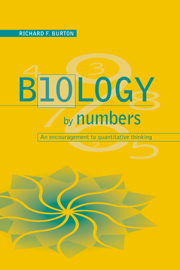Book contents
- Frontmatter
- Contents
- Preface
- A guide to the book
- 1 Putting two and two together
- 2 Units, formulae and the use of old envelopes: confronting some obstacles to quantitative thinking
- 3 Aspects of energy metabolism
- 4 Getting things in proportion
- 5 Perilous percentages, dangerous ratios
- 6 Building a trophic pyramid
- 7 Sodium in animals and plants
- 8 Exchanges of water and carbon dioxide
- 9 A geometric series
- 10 Introduction to logarithms
- 11 Bringing logarithms to life
- 12 Exponential relationships
- 13 Aspects of allometry
- 14 More on allometry, and on quantitative patterns in nature
- 15 How the abundance of food affects rates of feeding
- 16 The characterization of trees and other branching systems
- 17 Epilogue
- References
- Notes
- Index
3 - Aspects of energy metabolism
Published online by Cambridge University Press: 05 June 2012
- Frontmatter
- Contents
- Preface
- A guide to the book
- 1 Putting two and two together
- 2 Units, formulae and the use of old envelopes: confronting some obstacles to quantitative thinking
- 3 Aspects of energy metabolism
- 4 Getting things in proportion
- 5 Perilous percentages, dangerous ratios
- 6 Building a trophic pyramid
- 7 Sodium in animals and plants
- 8 Exchanges of water and carbon dioxide
- 9 A geometric series
- 10 Introduction to logarithms
- 11 Bringing logarithms to life
- 12 Exponential relationships
- 13 Aspects of allometry
- 14 More on allometry, and on quantitative patterns in nature
- 15 How the abundance of food affects rates of feeding
- 16 The characterization of trees and other branching systems
- 17 Epilogue
- References
- Notes
- Index
Summary
Many of the calculations in this book have to do with energy and with rates of photosynthesis and metabolism that may be expressed in terms either of energy itself or else of the equivalent oxygen or carbon dioxide exchange. This chapter is intended to pave the way for these, and is mainly concerned with the energy contents of pure carbohydrates, fats and proteins, with the energy actually available from particular foods, and with metabolic rates. Knowledge of the energy content of fat stores is then put to use in the context of human metabolic rate and the control of food intake. Finally, the ratio of carbon dioxide release to oxygen use (the ‘respiratory quotient’) is discussed in relation to birds' eggs. Energy is quantified in terms variously of kilocalories (kcal) and kilojoules (kJ) since biologists need to be familiar with both.
Energy from food
When glucose is produced in photosynthesis, a constant amount of solar energy is fixed per gram or per molecule. That same amount of energy is released when the glucose is broken back down to carbon dioxide and water in respiration, whether in the plant itself or in an animal that has eaten it. The same amount is also released when the glucose is converted to carbon dioxide and water by burning with oxygen and this ‘heat of combustion’ may be determined using a piece of apparatus known as a bomb calorimeter.
- Type
- Chapter
- Information
- Biology by NumbersAn Encouragement to Quantitative Thinking, pp. 44 - 50Publisher: Cambridge University PressPrint publication year: 1998



